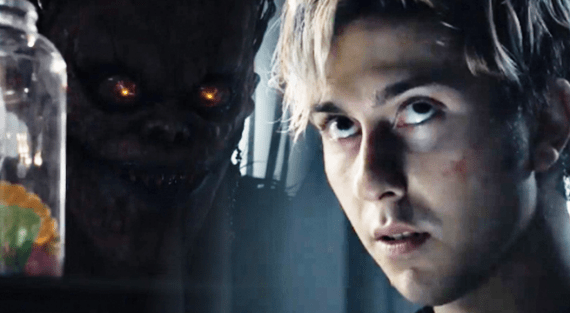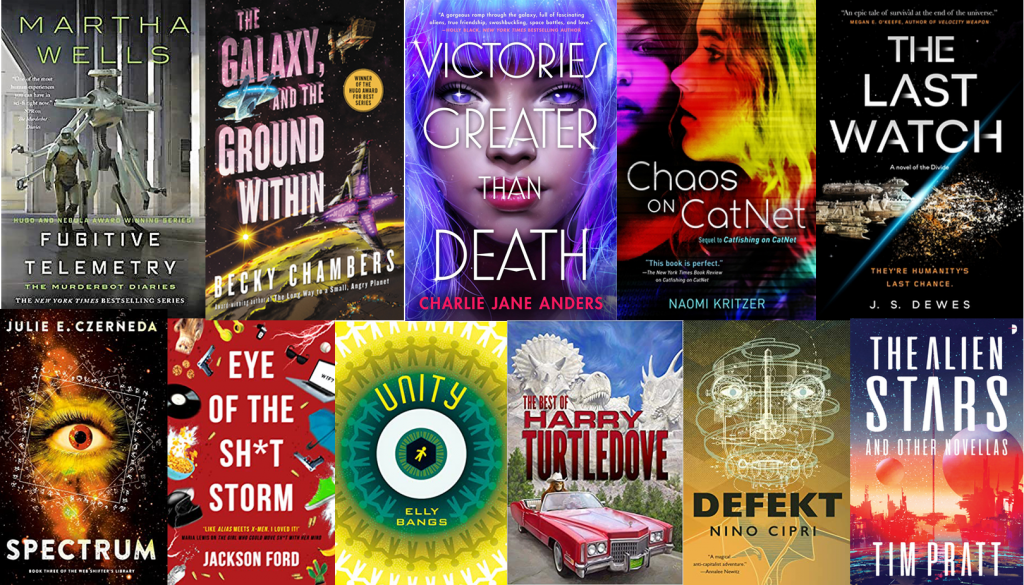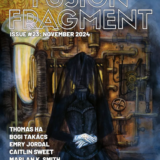
I owe you a bit of an apology: I slightly exaggerated the title of last week’s column, for effect. Actually, this is the “last call” for Aurora voters; you have only today—what’s left of it—and tomorrow until midnight (I think Eastern Daylight Time)—to vote.
I am finishing up the reading of all the eligible works before voting myself. It’s a big task, but by no means beyond your reach if you start now! So go to www.prixaurorawards.ca, pay your $10 (if you’re not already a Canadian SF/F Association member; this will make you a member for a full year), download the eligible works—almost all of them!–and vote! By the way, that’s why this column is so short—I’m still reading!

Figure 1 shows a “death god,” or shinigami, from the Japanese animé movie (2006), Death Note (Desu Nôtu). When they want to kill a human, they write the human’s name down in their notebook, and the human dies. The original Death Note was set in Japan and featured pretty much all Japanese characters (if you count the shinigami as Japanese characters). When Netflix decided to sponsor/air/whatever a new version of this movie, they changed an awful lot of stuff.
Mind you, I haven’t seen the original movie, but I’m guessing it hews pretty closely to the TV series (also 2006) of the same name; I’ve seen only a few of those so far. The changes are substantive enough that manga and animé fans have taken to IMDB to voice (okay, write) their disapproval in fairly large numbers. Let me give you a quick overview of the Netflix movie, then I’ll tell you a couple of things that I don’t think have been improved in the newer version. (By the way there have been numerous Japanese sequels over the last decade.)

Ryuk, a “death god,” drops a notebook near a high-school (or college?) student in Seattle, one Light Turner (Nat Wolff). (His father explained that his mom had been “a bit of a hippie,” which is supposed to explain his first name.) Light is writing some homework papers, something he does for other students to earn money, while watching his favourite cheerleader, Mia Sutton (Margaret Qualley), practice.
Thanks to Mia, Light’s extracurricular activities get exposed, and he is sentenced to after-school detention. While there, he opens the notebook, which is labeled Death Note, and is introduced to Ryuk (“It’s pronounced “ree-ook,” not “rye-uk,” the death god tells him.) Light freaks out while Ryuk explains what the Death Note is. Rule 1 says that if a human’s name is written in the book, they will die. There are at least 95 rules in the book; other rules include that you have to keep the person’s face in your mind as you write the name; you can specify the method of death; and so on.
Ryuk urges Light to try it out; Light finds himself sitting at his desk at home, while outside the window, Mia is being hassled by a group of local self-styled “tough guys.” Light writes the name of the main jerk in the book and, after prompting from Ryuk, writes “decapitation” next to it. “Watch,” Ryuk says, and Light sees a Rube Goldberg series of events outside, culminating in an aluminum ladder neatly knocking everything above the mandible off that boy’s head.

Light’s father (Shea Wigham) is a Seattle Police Department cop; that figures into the story. Light determines that if he uses this tool properly—to kill all the “bad guys,” Earth could soon be a paradise. In a short time, Light brings Mia into the picture and tells her the story; soon, they have killed over 400 notorious criminals worldwide.
Light and Mia create a fictitious “Kira” as the agent of death, and soon people everywhere believe Kira can save them from evil by killing evil. The supergenius young detective known to law enforcement only as “L” is brought into the picture; he’s played by Lakeith Stanfield.
An epic battle between “L,” who hides his face and has never lost a case, and the fictitious Kira begins—but “L” has already narrowed Kira’s location down to Seattle! Unfortunately, from here, the film begins to devolve a bit; I won’t give it away, but a lot of what you see in the latter half of the film becomes entirely predictable. Not all, but enough to give me, at least, a general feeling of dissatisfaction. (Side note: Ryuk is played [mocap] by Jason Liles; his face is CGI, and his voice is actually Willem Dafoe‘s)
So what’s the problem with the Netflix version vs. the Japanese version? Well, first off, there’s what’s called “whitewashing”—changing Asian characters to white for a Western audience (in fact, it appears that “L” is Japanese in the animé version; Lakeith Stanfield is black—so much for “whitewashing.”). Secondly, the original Light—Light Yagami—is a genius; in the animé he’s shown giving his “all-Japan” test scores to his mother; she says “Number one again? And your scores were higher this time!” We see no evidence that Light Turner is more than moderately smart.
Light Yagami determines that he will be a god in an earthly paradise after killing all the bad people; he is shown as egotistical to the point of mania. I’ve only seen a couple of episodes, but the tone of the Japanese one is much darker, all told.
Conclusion? Well, except that it slipped into predictability, I didn’t mind the Seattle one; but then I wasn’t already a big fan of the animé, so the differences didn’t bother me per se. I decry some whitewashing; that is, changing crucial characters to non-Asian, non-black and so on… but really, isn’t that a marketing thing? If you are going to make a live-action version of an animé, it makes sense (at least to the marketers) to aim at the largest ethnic demographic. At least, that’s what I think they’re doing…in the larger sense. When they whitewash a character with a major or large role for no particular reason, that’s when I disagree. There’s no reason to change an ethnic character if you have actors of the right ethnicity (or gender, for that matter—or age!) available.
And on another topic: a quick shout out to local newsperson Dawn Chubai, who plays (what else?) a news reporter in a cameo; we’ve lost Dawn to the East Coast and the Shopping Channel.
The animé version does intrigue me, and I plan to watch the rest of it, and maybe look up some of the sequels. It’s an interesting—if rather macabre and sanguine—concept. I’d give the Netflix one about 2 and a half dinguses. ¤¤+
Short takes: As I may have mentioned before, I’m enjoying Midnight, Texas, from a series of books by Charlaine Harris—if you know the name Sookie Stackhouse, you also know who Charlaine Harris is. And this is a lot less one-note than the vampire one; we have a vampire, a were-tiger, a witch, a genuine psychic who can see and talk to the dead; there’s also a fallen gay angel and a blonde contract killer. Lots of fun so far. Also, the Mercedes Man from the Stephen King book(s—it’s actually a trilogy) is, so far, absolutely superbly done. Brendan Gleeson is absolutely not the way I saw Bill Hodges in my mind, but he’s amazing in the role. I’m also enjoying a well-done non-genre Get Shorty, from the Elmore Leonard book. It’s a very NON-John Travolta version, which as of episode three, is even more like Leonard’s writing than the earlier movie version.
But now, alas, I must cease columning and go fill out my Aurora ballot. Fellow Canadians, if you haven’t already done so, do it now! Tomorrow is the absolute deadline (and I’d appreciate your vote if you like these columns!).
Surely, if you have time to read these, you have time to comment. I’d love to hear (good or bad) what you think of this column. All your comments are welcome, sincerely. And please, don’t feel you have to agree with me to comment. I learn much from dissenting views. Remember, my opinion is, as always, my own, and doesn’t necessarily reflect the views of Amazing Stories or its owners, editors, publishers or other columnists. See you next week!










